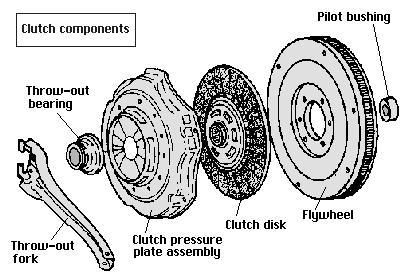Posting: #1
Cara Kerja Kopling - PemulaDiambil dari website clutchwizard  The clutch allows engine power to be applied gradually when a vehicle is starting out, interrupts power to the transmission to avoid gear clashing when shifting and prevents engine stalling when bringing the vehicle to a stop. Engaging the clutch (clutch pedal fully raised) allows power to transfer from the engine to the transmission and drive wheels. Disengaging the clutch (clutch pedal fully depressed) stops the power transfer and allows the engine to continue turning without force to the drive wheels. Common clutch-related components are: Flywheel – mounts to the engine crankshaft Clutch Disk – the friction material assembly that provides easy engagement and firm torque transference Pressure Plate – also known as “Clutch Cover” – this is the spring-loaded surface that locks the clutch Throw-out Bearing – also known as “Release Bearing” Pilot bearing –centers and supports the transmission input shaft (many cars do not have this bearing) Clutch Cable – mechanical release mechanism for some vehicles Clutch Master Cylinder – force-multiplying cylinder for vehicles with hydraulic release mechanisms Clutch Slave Cylinder – used along with a Master Cylinder for hydraulic release mechanisms Misc. hoses, lines, brackets, linkages, etc. – varies from vehicle to vehicle The flywheel is a large steel or aluminum disc. It acts as a balance weight for the engine, dampening engine vibrations caused by the firing of each cylinder and provides a surface that the clutch can contact. The flywheel also has teeth around its circumference for the starter motor to engage and crank the engine. The clutch disc is a steel plate, covered with a frictional material that is sandwiched between the flywheel and the pressure plate. The center of the disc is the hub, which fits the spines of the transmission input shaft. When the clutch is engaged, the disc is "squeezed" between the flywheel and pressure plate, and power from the engine is transmitted by the disc's hub to the input shaft of the transmission. A pressure plate is a metal spring-loaded friction surface that is bolted to the flywheel. It has a metal cover, heavy release springs, a metal pressure surface, and a thrust ring or fingers for the release bearing. The thrust ring or fingers release the clamping force of the springs when the clutch is disengaged. When the clutch pedal is depressed, the "Throw-out bearing" pushes the pressure plate's release fingers. The pressure plate pulls away from the clutch disc, disengaging the clutch, thus interrupting power flow. When the clutch pedal is released and the clutch is fully engaged, the release bearing is normally stationary and does not rotate with the pressure plate. Clutch operation is accomplished either mechanically or with a hydraulic pressure system. If a vehicle has a mechanically operated linkage, it will incorporate either a shaft-and-lever linkage arrangement or a cable. Systems that are made up of linkages, levers and pivot points are found primarily on older vehicles. These systems require regular lubrication and can only be designed to fit a limited range of configurations. A cable operated clutch mechanism is relatively simple. A cable connects the clutch pedal directly to the clutch release fork. This simple design is flexible and compact. There is however, a tendency for cables to gradually stretch and eventually break due to age and wear. On a hydraulically operated clutch, a master cylinder is usually directly operated by the clutch pedal assembly. A slave cylinder at the transmission is connected to the master cylinder by high-pressure tubing. The slave cylinder pushes either an operating lever or directly on the release bearing. Hydraulic systems require less pedal pressure and provide a smooth “liquid” feel to clutch engagement. Design configuration is very flexible and can very easily be adapted to most any required configuration. |
Sabtu, 21 Januari 2012
Cara Kerja Kopling
Langganan:
Posting Komentar (Atom)
Tidak ada komentar:
Posting Komentar